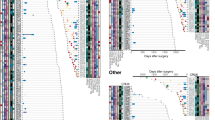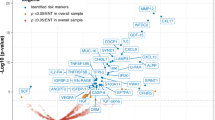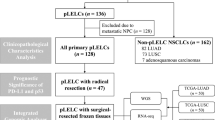Summary
The oncogene product epidermal growth factor receptor (EGF-R), the tumour suppressor gene product p53 and anti-p53 antibodies are detectable in the serum of certain cancer patients. Increased levels of some of these products were reported in lung cancer patients after occupational asbestos exposure and after exposure to polycyclic aromatic hydrocarbons or vinylchloride. In the first step, this study investigated the possible diagnostic value of serum EGF-R, p53-protein and anti-p53 antibodies, measured by an enzyme-linked immunosorbent assay, in lung tumour patients. In addition to being investigated on a molecular epidemiological basis, these parameters were examined as biomarkers of carcinogenesis, especially with regard to asbestos incorporation effects or of radon-induced lung cancers. Also, a possible effect of cigarette smoking and age dependence were studied. A total of 116 male patients with lung or pleural tumours were examined. The histological classification was four small-cell cancers, six large-cell cancers, 32 adenocarcinomas, 47 squamous carcinomas, 12 mixed lung carcinomas, five diffuse malignant mesotheliomas and ten lung metastasis of extrapulmonary tumours. Twenty-two lung cancers and all mesotheliomas were related to asbestos, 22 lung cancers were related to ionizing radiation and 61 patients had cigarette smoke-related lung cancer. Besides these patients 50 male patients with non-malignant lung or pleural diseases were included; of the latter eight subjects suffered from asbestosis. Controls were 129 male subjects without any lung disease. No significantly elevated or decreased serum values for p53 protein, EGF-R, or anti-p53 antibodies as a function of histological tumour type, age, or degree and type of exposure (asbestos, smoking, ionizing radiation) could be found. The utility of p53-protein, EGF-R and anti-p53 antibodies as routine biomarkers for screening occupationally derived lung cancers is limited.
Similar content being viewed by others
Article PDF
Change history
16 November 2011
This paper was modified 12 months after initial publication to switch to Creative Commons licence terms, as noted at publication
References
Angelopoulou, K., Diamandis, K. E., Sutherland, D. J., Kellm, J. A. & Bunting, P. S. (1994). Prevalence of serum antibodies against the p53 tumor suppressor gene protein in various cancers. Int J Cancer 58: 480–487.
Ambs, K. E., Takahashi, A., Hering, F., Costa, S. & Huber, P. R. (1989). Epidermal growth factor receptor in adenocarcinoma of the kidney. Urol Res 17: 251–254.
Barker, S. & Vinson, G. P. (1990). Epidermal growth factor in breast cancer. Int J Biochem 22: 939–945.
Birrer, M. J. & Brown, P. H. (1992). Application of molecular genetics to the early diagnosis and screening of lung cancer. Cancer Res 52: 2658s–2664s.
Brambilla, E., Gazzeri, S., Moro, D., Caron de Fromental, C., Gouyer, V., Jacrot, M. & Brambilla, C. (1993). Immunhistochemical study of p53 in human lung carcinomas. Am J Pathol 143: 199–210.
Brandt-Rauf, P. W. (1995). The c-erbB transmembrane growth factor receptors as serum biomarkers in human cancer studies. Mutat Res 333: 203–208.
Brandt-Rauf, P. W., Smith, S., Hemminki, K., Koskinen, H., Vainio, H., Niman, H. & Ford, J. (1992). Serum oncoproteins and growth factors in asbestosis and silicosis patients. Int J Cancer 50: 881–885.
Burkhart, C. (1994). Das Tumorsuppressorprotein p53. Dtsch Ärzteblatt 91: 898–904.
Butz, M. (1996). Beruflich verursachte Krebserkrankungen. Schriftenreihe des Hauptverbandes der gewerblichen Berufsgenossenschaften: St. Augustin, Germany
Choi, J. H., Oh, J. Y., Ryu, S. K., Kim, S. J., Lee, N. Y., Kim, K. S., Yi, S. Y., Shim, K. S. & Han, W. S. (1997). Detection of epidermal growth factor receptor in the serum of gastric carcinoma patients. Cancer 79: 1879–1893.
De Vuyst, P. (1997). Guidelines for attribution of lung cancer to asbestos. In Proceedings of an International Expert Meeting on Asbestos, Asbestosis and Cancer, People and Work, Research Reports 14: 92–96, Finnish Institute of Occupational Health: Helsinki, Finland
Eigenwillig, G. G. (1997). Berufliche Strahlenexposition durch Radon und dessen Folgeprodukte. Konsequenzen für die Anerkennung als Berufskrankheit. Dtsch Ärzteblatt 94: 1057–1062.
Fontanini, G., Fiore, L., Bigini, D., Vignati, S., Calvo, S., Mussi, A., Lucci, M., Angeletti, C. A. & Merlo Basolo, F. (1994). Levels of p53 antigen in serum of non-small cell lung cancer patients correlate with positive p53 immunohistochemistry on tumor sections, tumor necrosis and nodal involvment. Int J Oncol 5: 553–558.
Haeder, M., Rotsch, M., Bepler, G., Henning, C., Havemann, K., Heimann, B. & Moelling, K. (1988). Epidermal growth factor receptor expression in human lung cancer cell lines. Cancer Res 48: 1132–1136.
Hanaoka, T., Yamano, Y., Katsuno, N., Kagawa, J. & Ishizu, S. (1997). Elevated serum levels of pantropic p53 in chronium workers. Scand J Work Environ Health 23: 37–40.
Harris, C. C. & Hollstein, M. (1993). Clinical implications of the p53 tumor-suppressor gene. New Engl J Med 329: 1318–1327.
Horio, Y., Suzuki, H., Ueda, R., Koshikaea, T., Sigura, T., Ariyoshi, Y., Shimokata, K. & Takahashi, T. (1994). Predominantly tumor-limited expression of a mutant allele in a Japanese family carrying a germline p53 mutation. Oncogene 9: 1231–1235.
Husgafvel-Pursiainen, K., Kannio, A., Oksa, P., Suitiala, T., Koskinen, R., Hemminiki, K., Smith, S., Rosenstock-Leibu, R. & Brandt-Rauf, P. (1997). Mutations, tissue accumulations, and serum levels of p53 in patients with occupational cancers from asbestos and silica exposure. Environ Mol Mutagen 30: 224–230.
Kaye, F. J., Kim, Y. W. & Otterson, G. A. (1995). Molecular biology of lung cancer. In Molecular Genetics of Cancer, Cowell JK (ed.), pp. 179–204. BIOS Scientific: Oxford
Lahdeaho, M. L., Lehtinen, T., Aine, R., Hakala, T. & Lehtinen, M. (1994). Antibody response to adenovirus E1b-derived synthetic peptides and serum levels of p53 in patients with gastrointestinal and other malignant lymphomas. J Med Virol 43: 393–396.
Levesque, M. A., D’Casta, M. & Diamandis, E. P. (1996). p53 protein is absent from serum of patients with lung cancer. Br J Cancer 74: 1434–1440.
Lubin, R., Zalcman, G., Bouchet, L., Tredaniel, J., Lagros, Y., Cazals, D., Hirsch, A. & Soussi, T. (1995). Serum p53 antibodies as early markers of lung cancer. Nat Med 1: 701–702.
Luo, J. C., Zehab, R., Antilla, S., Ridanpää, M., Husgafvel-Pursiainen, K., Vaino, H., Carney, W., DeVivo, J., Milling, C. & Brandt-Rauf, P. W. (1994). Detection of serum p53 protein in lung cancer patients. J Occup Med 36: 155–160.
Micelli, G., Donaded, A. & Quaranta, M. (1992). The p53 tumor suppressor gene. A preliminary clinical study in breast cancer patients. Cell Biophys 21: 25–31.
Minna, J. D. (1993). The molecular biology of lung cancer pathogenesis. Chest 103: 449–456.
Mudena, B., Green, J. A., Green, B., Jenkins, J. R., Robertson, L., Tarunina, M. & Leinster, S. J. (1994). The relationship between serum p53 autoantibodies and characteristics of human breast cancer. Br J Cancer 69: 1115–1119.
Nuorva, U., Makitaro, R., Huhti, E., Kamel, D., Vähäkangas, K., Bloigu, R., Soini, Y. & Paakko, P. (1994). p53 protein accumulation in lung carcinomas of patients exposed to asbestos and tobacco smoke. Am J Respir Crit Care Med 150: 528–533.
Parker, J. E. (1997). Radiological criteria: the use of chest imaging techniques in asbestos-related diseases. In Proceedings of an International Expert Meeting on Asbestos, Asbestosis and Cancer, People and Work, Research Reports 14: Finnish Institute of Occupational Health: Helsinki, Finland 28–40.
Partanen, R., Hemminki, K., Brandt-Rauf, P. W., Jin, C. G. & Koskinen, H. (1994a). Serum levels of growth factor receptors, EGFR and Neu in asbestosis patients: A follow-up study. Int J Oncol 4: 1025–1028.
Partanen, R., Hemminki, K., Koskinen, H., Luo, J. C., Carney, W. P. & Brandt-Rauf, P. W. (1994b). The detection of increased amounts of the extracellular domain of the epidermal growth factor receptor in serum during carcinogenesis in asbestosis patients. J Occup Med 36: 1324–1328.
Pavelic, K., Banjac, Z., Pavelic, J. & Spaventi, S. (1993). Evidence for a role of EGF receptor in the progression of human lung carcinoma. Anticancer Res 14: 1133–1137.
Preudhomme, C., Lubin, R., Lepelley, P., Vanzumbeke, M. & Fenaux, P. (1994). Detection of serum anti p53 antibodies and their correlation with p53 mutations in myelodysplastic syndrom and acute myeloid leukemia. Leukemia 8: 1589–1591.
Rosenfeld, M. R., Malats, N., Schramm, L., Graus, F., Cardenal, F., Vinolas, N., Rosell, R., Tora, M., Real, F. X., Posner, J. B. & Dalmau, J. (1997). Serum anti-p53 antibodies and prognosis of patients with small-cell lung cancer. J Natl Cancer Inst 89: 381–385.
Rusch, V., Baselga, J., Cordon-Cardo, J., Orazem, J., Zaman, M., Hoda, S., McIntosh, J., Kurie, J. & Dmitrovsky, E. (1993). Differential expression of the epidermal growth factor receptor and its ligands in primary non-small-cell lung cancers and adjacent benign lung. Cancer Res 53: 2379–2385.
Schlichtholz, B., Tredaniel, J., Lubin, R., Zalcman, G., Hirsch, A. & Soussi, T. (1994). Analysis of p53 antibodies in sera of patients with lung carcinoma define immunodominant regions in the p53 protein. Br J Cancer 69: 809–816.
Segawa, Y., Tagigawa, N., Mandai, K., Maeda, Y., Takata, I., Fujimoto, N. & Jnno, K. (1997). Measurement of serum p53 protein in patients with small cell lung cancer and results of its clinicopathological evaluation. Lung Cancer 16: 229–238.
Sorscher, S. M., Russak, V., Graziano, V., Cagle, M., Feramisco, J. R. & Green, M. R. (1995). Immunohistochemical evaluation of E-cadherin and epidermal growth factor receptor in non-small-cell lung cancer. Mod Pathol 8: 450–455.
Sozzi, G., Miozzo, M., Tagliabue, E., Calderone, C., Lombardi, L., Pilotti, S., Pastorino, U., Pierotti, M. A. & DellaPorta, G. (1991). Catogenetic abnormalities and overexpression of receptors for growth factors in normal bronchial epithelium and tumor samples of lung cancer patients. Cancer Res 51: 400–404.
Sugimura, H., Weston, A., Caporaso, N., Shields, P. G., Bowman, E. D., Metcalf, R. A. & Harris, C. C. (1991). Biochemical and molecular epidemiology of cancer. Biomed Environ Sci 4: 73–92.
Taylor, J. A., Watson, M. A., Devereux, T. R., Michels, R. Y., Saccomanno, G. & Anderson, M. (1994). p53 mutations hotspot in radon-associated lung cancer. Lancet 343: 86–87.
Trivers, G. E., Cawley, H. L., DeBenedetti, V. M., Hollstein, M., Marion, M. J., Bennett, W. P., Hoover, M. L., Price, C. C., Tamburro, C. C. & Harris, C. C. (1995). Anti-p53 antibodies in sera of workers occupationally exposed to vinyl chloride. J Natl Cancer Inst 87: 1400–1407.
Trumper, L., Jung, W., Dahl, G., Diehl, V., Gause, A. & Pfrundschuh, M. (1994). Interleukin-7, interleukin-8, soluble TNF receptor and p53 protein levels are elevated in the serum of patients with Hodgkin’s disease. Ann Oncol 5: 93–96.
Vähäkangas, K. H., Samet, J. M., Metcalf, R. A., Welsh, J. A., Bennett, W. P., Lane, D. P. & Harris, C. C. (1992). Mutations of p53 and ras genes in radon-associated lung cancer from uranium miners. Lancet 339: 576–580.
van Zandwijk, N., Mooi, W. J. & Rodenhuis, S. (1995). Prognostic factors in NSLCL. Recent experiences. Lung Cancer 12: 27–33.
Weissfeld, J. L., Larsen, R. D., Niman, H. L. & Kuller, L. H. (1994). Evaluation of oncogene-related proteins in serum. Cancer Epidemiol Biomarkers Prev 3: 57–62.
Wild, C. P., Ridanpää, M., Antilla, S., Lubin, R., Soussi, T., Husgavfel-Pursianen, K. & Vainio, H. (1995). p53 antibodies in the sera of lung cancer patients: comparison with p53 mutations in the tumor tissue. Int J Cancer 64: 176–181.
Winter, S. F., Minna, J. D., Johnson, B. E., Takahashi, T., Gazdar, A. F. & Carbone, D. P. (1992). Development of antibodies against p53 in lung cancer patients appears to be dependent on the type of p53 mutation. Cancer Res 52: 4168–4174.
Winter, S. F., Sekido, Y., Minna, J. D., McIntire, D., Johnson, B. E., Gazdar, A. F. & Carbone, D. P. (1993). Antibodies against autologous tumour cell proteins in patients with small-cell lung cancer: associated with improved survival. J Natl Cancer Inst 85: 2018
Wynford-Thomas, D. (1991). Oncogenes and anti-oncogenes; the molecular basis of tumour behaviour. J Pathol 165: 187–201.
Author information
Authors and Affiliations
Rights and permissions
From twelve months after its original publication, this work is licensed under the Creative Commons Attribution-NonCommercial-Share Alike 3.0 Unported License. To view a copy of this license, visit http://creativecommons.org/licenses/by-nc-sa/3.0/
About this article
Cite this article
Schneider, J., Presek, P., Braun, A. et al. p53 protein, EGF receptor, and anti-p53 antibodies in serum from patients with occupationally derived lung cancer. Br J Cancer 80, 1987–1994 (1999). https://doi.org/10.1038/sj.bjc.6690632
Received:
Revised:
Accepted:
Published:
Issue date:
DOI: https://doi.org/10.1038/sj.bjc.6690632
Keywords
This article is cited by
-
Comparative proteomic analysis in serum of former uranium miners with and without radon induced squamous lung cancer
Journal of Occupational Medicine and Toxicology (2019)
-
Autoantibodies as diagnostic biomarkers for lung cancer: A systematic review
Cell Death Discovery (2019)
-
Serum p53 protein and anti-p53 antibodies are associated with increased cancer risk: a case–control study of 569 patients and 879 healthy controls
Molecular Biology Reports (2010)
-
Alteration of the serum levels of the epidermal growth factor receptor and its ligands in patients with non-small cell lung cancer and head and neck carcinoma
British Journal of Cancer (2007)



